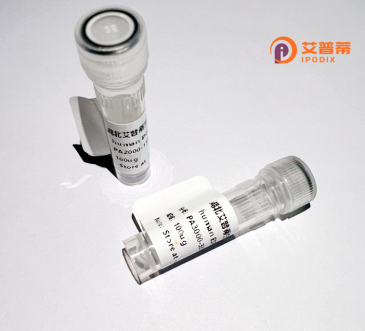
| 纯度 | >90%SDS-PAGE. |
| 种属 | Human |
| 靶点 | BTG1 |
| Uniprot No | P62324 |
| 内毒素 | < 0.01EU/μg |
| 表达宿主 | E.coli |
| 表达区间 | 1-171aa |
| 氨基酸序列 | MHPFYTRAATMIGEIAAAVSFISKFLRTKGLTSERQLQTFSQSLQELLAEHYKHHWFPEKPCKGSGYRCIRINHKMDPLIGQAAQRIGLSSQELFRLLPSELTLWVDPYEVSYRIGEDGSICVLYEASPAGGSTQNSTNVQMVDSRISCKEELLLGRTSPSKNYNMMTVSG |
| 分子量 | 44.55 kDa |
| 蛋白标签 | GST-tag at N-terminal |
| 缓冲液 | 冻干粉 |
| 稳定性 & 储存条件 | Lyophilized protein should be stored at ≤ -20°C, stable for one year after receipt. Reconstituted protein solution can be stored at 2-8°C for 2-7 days. Aliquots of reconstituted samples are stable at ≤ -20°C for 3 months. |
| 复溶 | Always centrifuge tubes before opening.Do not mix by vortex or pipetting. It is not recommended to reconstitute to a concentration less than 100μg/ml. Dissolve the lyophilized protein in distilled water. Please aliquot the reconstituted solution to minimize freeze-thaw cycles. |
以下是3篇与重组人蛋白BTG1相关的研究文献简要归纳:
1. **"BTG1 regulates self-renewal and epigenetic stability in embryonic stem cells"**
*Author: Park et al.*
揭示BTG1通过抑制SIRT1去乙酰化酶活性,维持胚胎干细胞的表观遗传稳定性和自我更新能力,其重组蛋白体外实验证明可调控组蛋白乙酰化。
2. **"BTG1 inhibits proliferation in breast cancer cells by regulating ERK1/2 phosphorylation"**
*Author: Lim et al.*
研究发现重组BTG1通过结合并抑制MEK-ERK信号通路,降低乳腺癌细胞的增殖与迁移能力,提示其作为肿瘤治疗靶点的潜力。
3. **"BTG1 interaction with Caf1 component of CCR4-NOT complex enhances mRNA deadenylation"**
*Author: Rouault et al.*
证实重组BTG1蛋白通过与CCR4-NOT复合物的Caf1亚基结合,加速mRNA的脱腺苷酸化过程,调控基因表达的转录后机制。
4. **"Clinical significance of BTG1 methylation in hepatocellular carcinoma prognosis"**
*Author: Yang et al.*
通过临床样本分析,发现BTG1启动子甲基化导致其表达下调,与肝癌患者生存率显著相关,重组BTG1表达可抑制肝癌细胞体内成瘤性。
以上研究涵盖BTG1在表观调控、肿瘤抑制、mRNA代谢及临床预后方面的核心功能。
BTG1 (B-cell translocation gene 1) is a member of the BTG/TOB protein family, known for its role in regulating cell cycle progression, differentiation, and apoptosis. Initially identified through chromosomal translocations in B-cell lymphomas, human BTG1 is encoded on chromosome 12q22 and produces a 19 kDa nuclear protein. It functions as a transcriptional co-regulator by interacting with components of the CCR4-NOT deadenylase complex, promoting mRNA decay and translational inhibition. BTG1 also modulates chromatin remodeling by associating with histone modification enzymes like PRMT1.
As a tumor suppressor, BTG1 is involved in DNA damage response pathways and inhibits cell proliferation by suppressing cyclin D1 and E2F-driven transcription. Its dysregulation has been linked to cancers, including breast tumors, gliomas, and hematological malignancies. Recombinant BTG1 (rBTG1) is typically expressed in *E. coli* or mammalian systems for functional studies, enabling exploration of its anti-proliferative activity and therapeutic potential. Research on rBTG1 has advanced understanding of its post-translational modifications, interactome, and roles in stem cell maintenance or chemoresistance. Its conserved N-terminal BTG domain mediates key protein interactions, while the C-terminal region influences subcellular localization. Current studies focus on leveraging rBTG1 to develop strategies for cancer therapy and regenerative medicine.
×